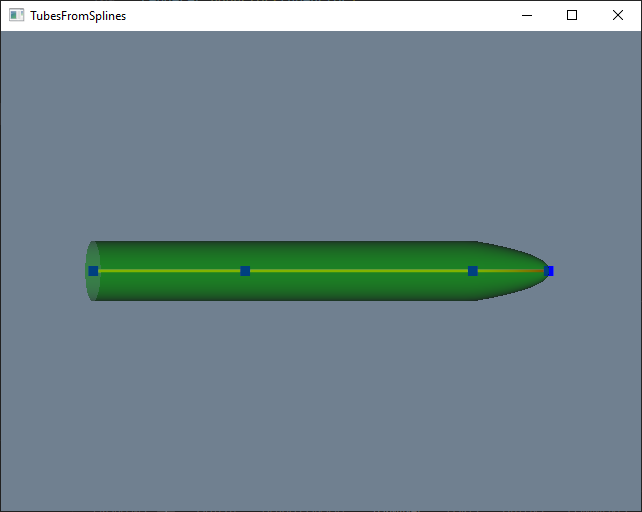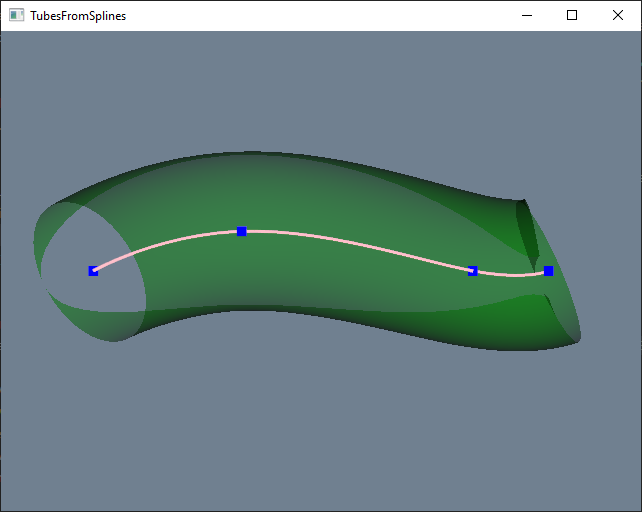Hi there,
I have an issue when using the vtkTubeFilter, it works fine and I am able to render a proper tube with a varying radius. After changing the underlying spline and points, which work fine, the next rendering shows the tube with a constant radius of 0.5. Somehow the radius information must have gotten lost, despite the fact that the polydata still has the active scalar set to the propper array with correct radius values in it.
Here is my code:
import vtk
import time
colors = vtk.vtkNamedColors()
points = vtk.vtkPoints()
points.InsertNextPoint(0, 0, 0)
points.InsertNextPoint(1, 0, 0)
points.InsertNextPoint(2.5, 0, 0)
points.InsertNextPoint(3, 0, 0)
# Fit a spline to the points.
spline = vtk.vtkParametricSpline()
spline.SetPoints(points)
spline.ParameterizeByLengthOff()
functionSource = vtk.vtkParametricFunctionSource()
functionSource.SetParametricFunction(spline)
functionSource.SetUResolution(10 * points.GetNumberOfPoints())
functionSource.Update()
# Interpolate the scalars.
interpolatedRadius = vtk.vtkTupleInterpolator()
interpolatedRadius.SetInterpolationTypeToLinear()
interpolatedRadius.SetNumberOfComponents(1)
interpolatedRadius.AddTuple(0, [.2])
interpolatedRadius.AddTuple(1, [.2])
interpolatedRadius.AddTuple(2, [.2])
interpolatedRadius.AddTuple(3, [.01])
# Generate the radius scalars.
tubeRadius = vtk.vtkDoubleArray()
tubeRadius.SetNumberOfComponents(1)
tubeRadius.SetName("TubeRadius")
num_points = functionSource.GetOutput().GetNumberOfPoints()
tubeRadius.SetNumberOfTuples(num_points)
tMin = interpolatedRadius.GetMinimumT()
tMax = interpolatedRadius.GetMaximumT()
r = [0]
for i in range(num_points):
t = (tMax - tMin) / (num_points - 1) * i + tMin
interpolatedRadius.InterpolateTuple(t, r)
tubeRadius.SetTuple1(i, r[0])
# Add the scalars to the polydata.
tube_poly_data = functionSource.GetOutput()
tube_poly_data.GetPointData().AddArray(tubeRadius)
tube_poly_data.GetPointData().SetActiveScalars("TubeRadius")
# Create the tubes.
tube_filter = vtk.vtkTubeFilter()
tube_filter.SetInputData(tube_poly_data)
tube_filter.SetNumberOfSides(64)
tube_filter.SetVaryRadiusToVaryRadiusByAbsoluteScalar()
# Setup actors and mappers.
tube_mapper = vtk.vtkPolyDataMapper()
tube_mapper.SetInputConnection(tube_filter.GetOutputPort())
tube_mapper.ScalarVisibilityOff()
point_colors = vtk.vtkUnsignedCharArray()
point_colors.SetNumberOfComponents(3)
point_colors.SetName('Colors')
point_colors.InsertNextTuple(vtk.vtkNamedColors().GetColor3ub("Blue"))
point_colors.InsertNextTuple(vtk.vtkNamedColors().GetColor3ub("Blue"))
point_colors.InsertNextTuple(vtk.vtkNamedColors().GetColor3ub("Blue"))
point_colors.InsertNextTuple(vtk.vtkNamedColors().GetColor3ub("Blue"))
points_polydata = vtk.vtkPolyData()
points_polydata.SetPoints(points)
points_polydata.GetPointData().SetScalars(point_colors)
points_vertex_glyph_filter = vtk.vtkVertexGlyphFilter()
points_vertex_glyph_filter.SetInputData(points_polydata)
points_polydata_mapper = vtk.vtkPolyDataMapper()
points_polydata_mapper.SetInputConnection(points_vertex_glyph_filter.GetOutputPort())
pointActor = vtk.vtkActor()
pointActor.SetMapper(points_polydata_mapper)
pointActor.GetProperty().SetPointSize(10)
line_mapper = vtk.vtkPolyDataMapper()
line_mapper.SetInputConnection(functionSource.GetOutputPort())
lineActor = vtk.vtkActor()
lineActor.SetMapper(line_mapper)
lineActor.GetProperty().SetLineWidth(3)
lineActor.GetProperty().SetColor(colors.GetColor3d("Pink"))
tubeActor = vtk.vtkActor()
tubeActor.SetMapper(tube_mapper)
tubeActor.GetProperty().SetOpacity(0.5)
tubeActor.GetProperty().SetColor(colors.GetColor3d("Green"))
# Setup render window, renderer, and interactor.
renderer = vtk.vtkRenderer()
renderer.UseHiddenLineRemovalOn()
renderWindow = vtk.vtkRenderWindow()
renderWindow.AddRenderer(renderer)
renderWindow.SetSize(640, 480)
renderWindow.SetWindowName("TubesFromSplines")
renderWindowInteractor = vtk.vtkRenderWindowInteractor()
renderWindowInteractor.SetRenderWindow(renderWindow)
renderer.AddActor(lineActor)
renderer.AddActor(tubeActor)
renderer.AddActor(pointActor)
renderer.SetBackground(colors.GetColor3d("SlateGray"))
renderWindow.Render()
print("done....")
time.sleep(1)
print("change points...")
points.SetPoint(1, 1, 0.25, 0.25)
points.Modified()
spline.Modified()
renderWindow.Render()
print("change points...ok")
renderWindowInteractor.Start()

